
Without a doubt, pink is one of the most loved colors, but also one of the richest and most controversial. It not only comes in dozens of shades but also carries profound meanings and is linked to various ideas and symbolism.
Today, it is one of the trendiest colors in fashion, art, costumes, design, and architecture. For centuries, it was a "neutral" color, genderless, used by both men and women.
In the last century, there has been an important shift that has associated pink with the female gender. But behind pink, there is a rich and varied world to discover.
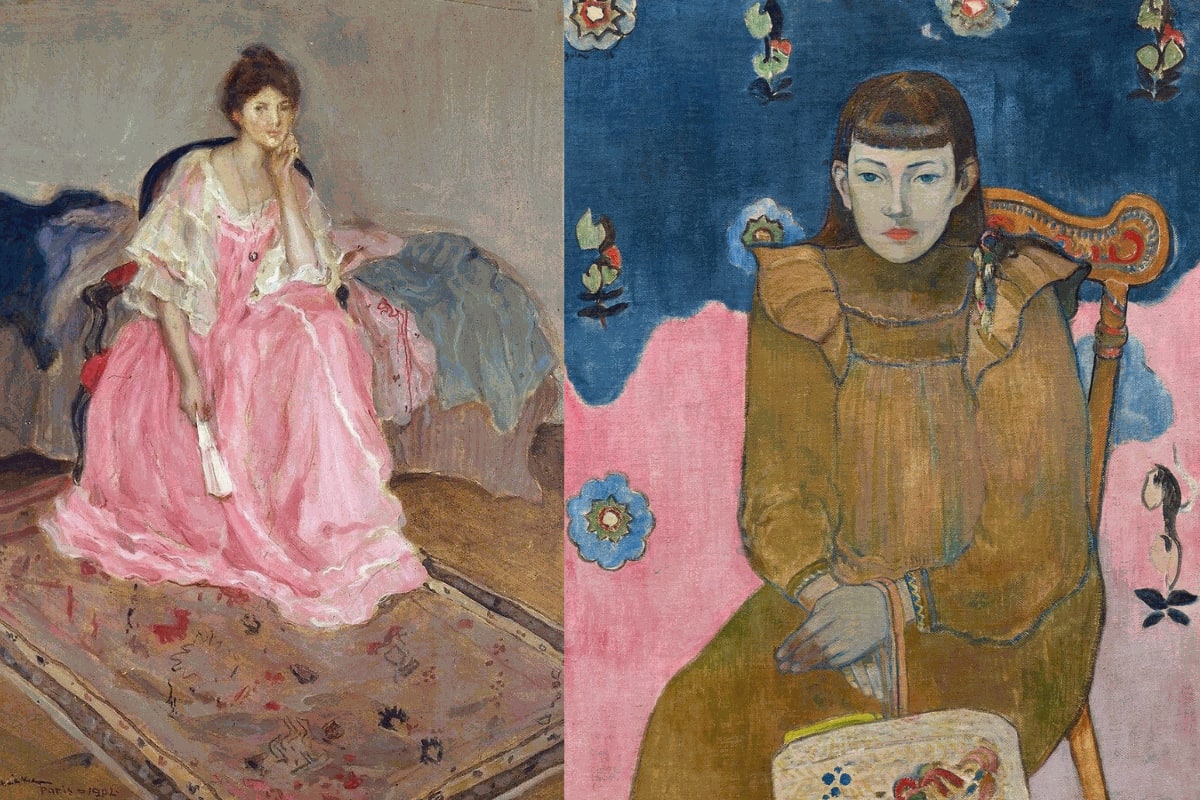
Its symbolic meanings are diverse. Indeed, it symbolizes altruistic love and the sensitivity of the human soul, but also youth and innocence.
Indeed, pink is created by adding the color white to red. The intensity of red is softened by the purity of white, resulting in a completeness that inspires sweetness, kindness, sophistication, and tranquility.
Just as red expresses the idea of passion, pink conveys affection and is synonymous with fondness and friendship. The color pink also symbolizes femininity, charm, sensitivity, tenderness, and romanticism. It is a very delicate color often associated with flowers, children, and girls.
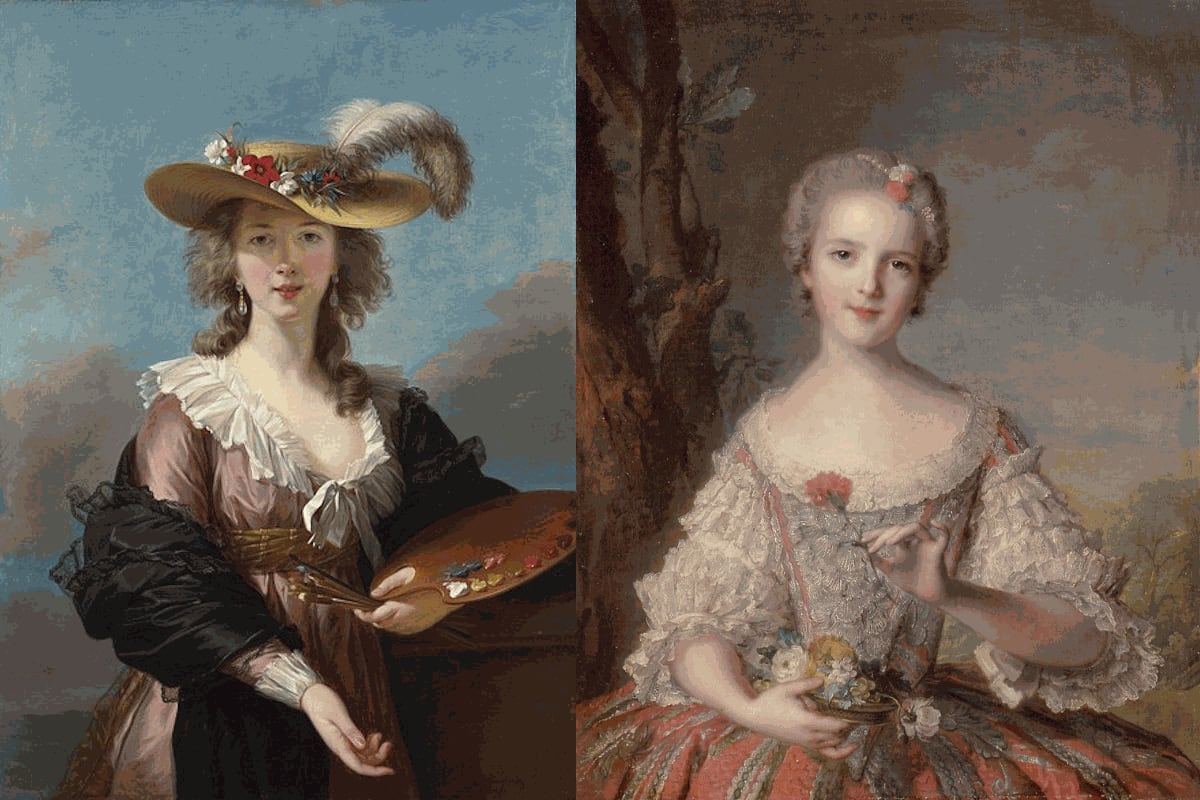
Self-Portrait in a Straw Hat by Élisabeth Vigée Le Brun, 1782 & Madame Luise de France by Jean-Marc Nattier, 1748
Pink is also synonymous with universal love for others and for oneself, and is also associated with the idea of good health.
In fact, the English phrase "to be in the pink" expresses the idea of being in good health. This expression seems to trace back not to the color itself, but to the homonymous flower, the carnation.
In Italian, the phrase"vedere tutto rosa" (seeing everything in pink) indicates an optimistic attitude towards life, much like the French expression "voir la vie en rose."
In the Catholic religion, pink symbolizes joy and happiness.
THE COLOR OF SERENITY
As we've already mentioned, pink is a shade that conveys tranquility and security, managing to calm and instill serenity. This color with its great relaxing properties can dispel feelings of anxiety and fear. It helps combat stress and the sensation of loneliness, as well as reduce anger and aggression.
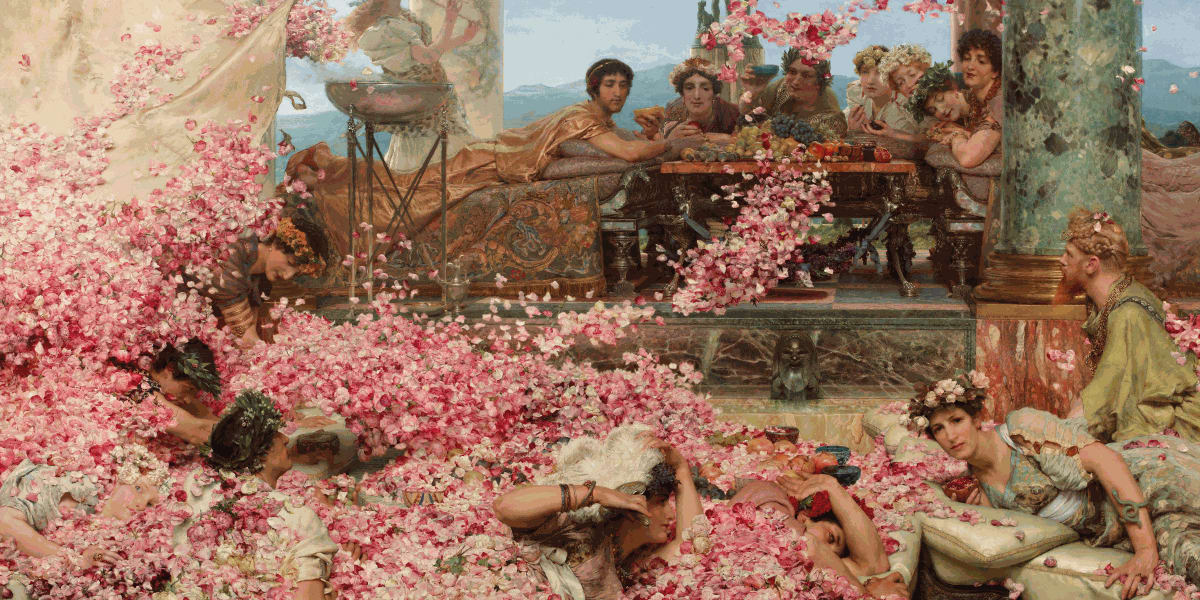
The Roses of Heliogabalus by Lawrence Alma-Tadema ,1888
In the 1960s and 1970s, numerous scientific studies demonstrated the relaxing effects of a certain shade of pink, capable of lowering muscle tension and heart rate within a few minutes. Specifically, darker shades of pink can intensify emotions, while lighter pinks are much more calming.
Following this discovery, it was decided to use pink in some American prisons to encourage inmates to maintain calm behavior, avoiding displays of violence and rebellion. This resulted in an actual decrease in violent incidents.

Tide Dance (118 x 78 cm) by Jana Brike, 2022
PINK IN ARCHITECTURE: COLOR AS LIGHT AND ACCEPTANCE

Palazzo Brandolini Rota in Venice (left) & Benrath Palace in Düsseldorf (right)
In particular, according to a study by Alexander Schauss conducted in the 1960s, a specific shade of pink (Baker Miller Pink or Pink P-618) was identified by behavioral psychology as capable of triggering the release of specific hormones by our endocrine system, which slow down heart rate and breathing.
Anyone who sees a glimpse of architecture dominated by the color pink immediately notices the sense of calm and serenity that washes over them. Pink-colored walls inside a space or buildings painted in this hue along any street can be a true balm for our eyes.
Pink, used in the practice of historical architecture, is a color often found in ancient city centers as well as seaside villages.
Wherever we find pink, we are in places of color, designed to instill an atmosphere of peace and harmony.
PINK AND SCIENCE
Despite the term indicating the color's name entering the dictionary relatively late, only at the end of the 17th century, according to a group of Australian researchers, pink might be the oldest biological color in the world. It seems that this color dates back more than 1.1 billion years ago.
This discovery was made by a young researcher at the Australian National University, Nur Gueneli, who, in 2017, extracted the pigment from a group of rocks found by an oil company ten years earlier in Mauritania, in the Taoudeni Basin, south of the Sahara.
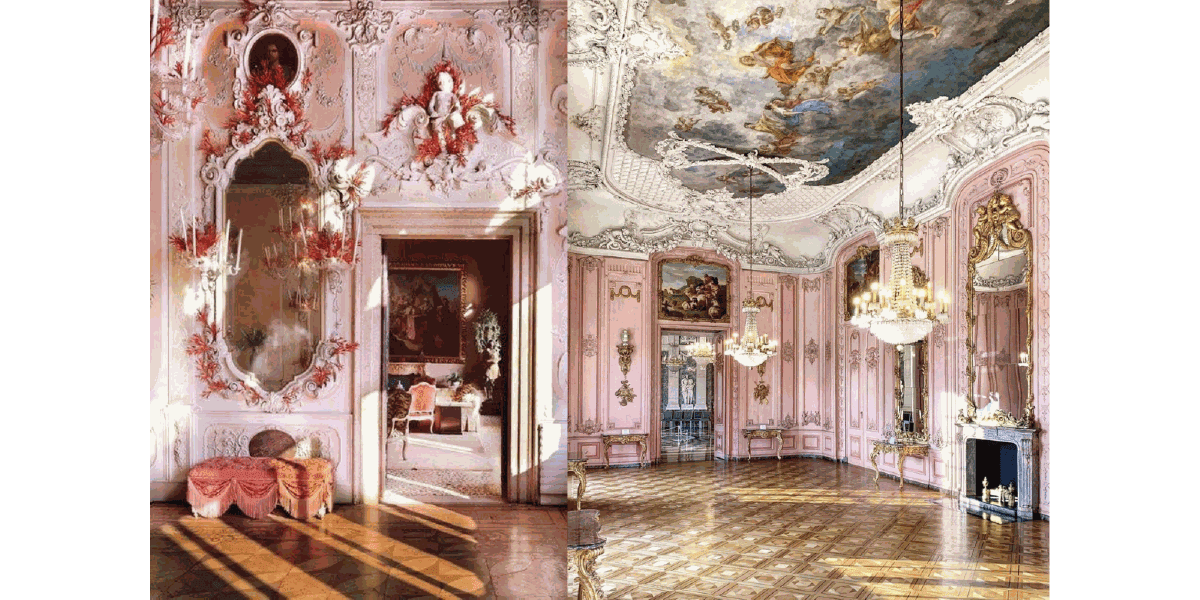
Yuki The Young Yak by Mark Ryden, 2021 (Limited Edition Print) | Baby Bos by Mark Ryden (Limited Edition Toy)
"Pink reveals an idea of ecstasy in frivolity."
Charles Baudelaire
According to Nur Gueneli, these (new) bright pink shades are more than 500 million years older than the oldest known pigments and are the product of ancient oceanic organisms.
As she explained to Business Insider: "The bright pink pigments are molecular fossils of chlorophyll produced by ancient photosynthetic organisms that lived in an ancient ocean - long before the dinosaurs roamed the Earth."
Pink was used by cyanobacteria, single-celled organisms dedicated to photosynthesis, to attract light, and through this function, they became crucial for human evolution.
To discover these pigments, researchers crushed billion-year-old rocks into powder, extracted and analyzed each individual molecule obtained. When diluted, these ancient pigments appear bright pink, but when concentrated, they can range from vivid red to deep purple.
[Sources: "Il rosa è il colore più antico del mondo (e racchiude il segreto della vita) lo dice la scienza" di Claudia Santini, ELLE )
"Il rosa? Da sempre senza limiti" di Michele Venturini, MEER]
THE HISTORY OF PINK

Girl With A Kitten, (2007) & Girl Holding a Doll (30 x 40 cm) (2018) by Marion Peck
Indeed, from in-depth studies, we know that the first colors used by humans were derived from natural earth pigments, thus falling within the range of browns. Pink emerged as a consequence of the discovery of red. Red pigment can be traced back to as early as 800 B.C. It was produced by the Chinese, who obtained it from cinnabar, a compound of mercury. Pink arose from the dilution of red pigment.
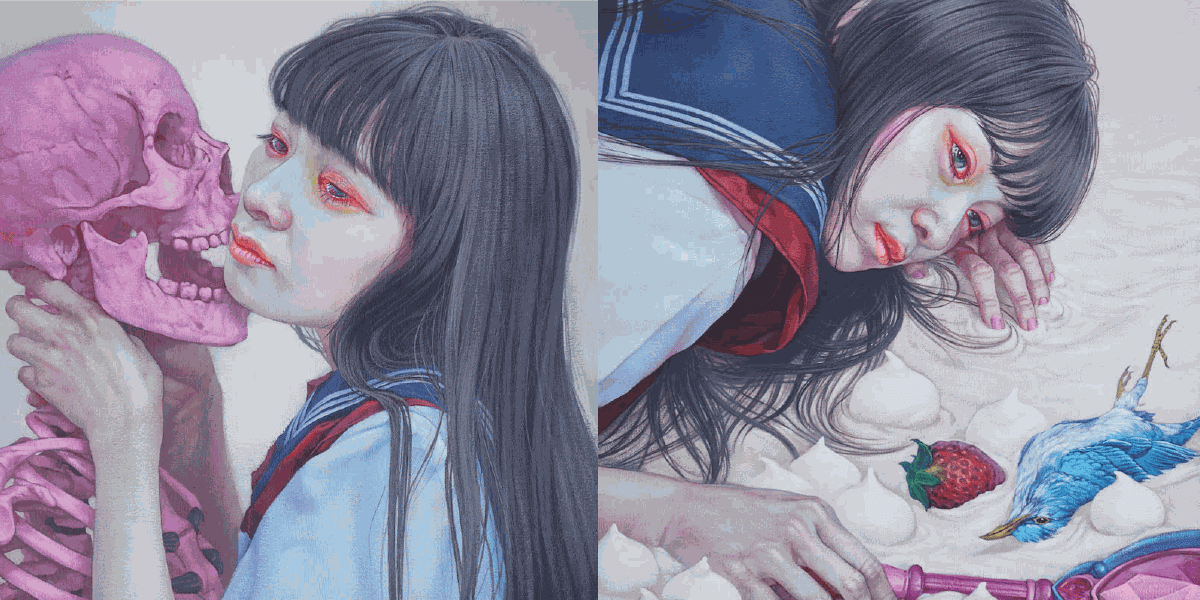
Unfulfilled Dream (51 x 36 cm) & Suicide (30 x 30 cm) by Kazuhiro Hori, 2022
Some English scholars argue that the preference for the color pink is a natural inclination, dating back to the time when women were involved in gathering crops. Over centuries, women developed a growing sensitivity to colors tending towards red, the hues of ripe fruits. However, the association between pink and women occurred only in recent times.
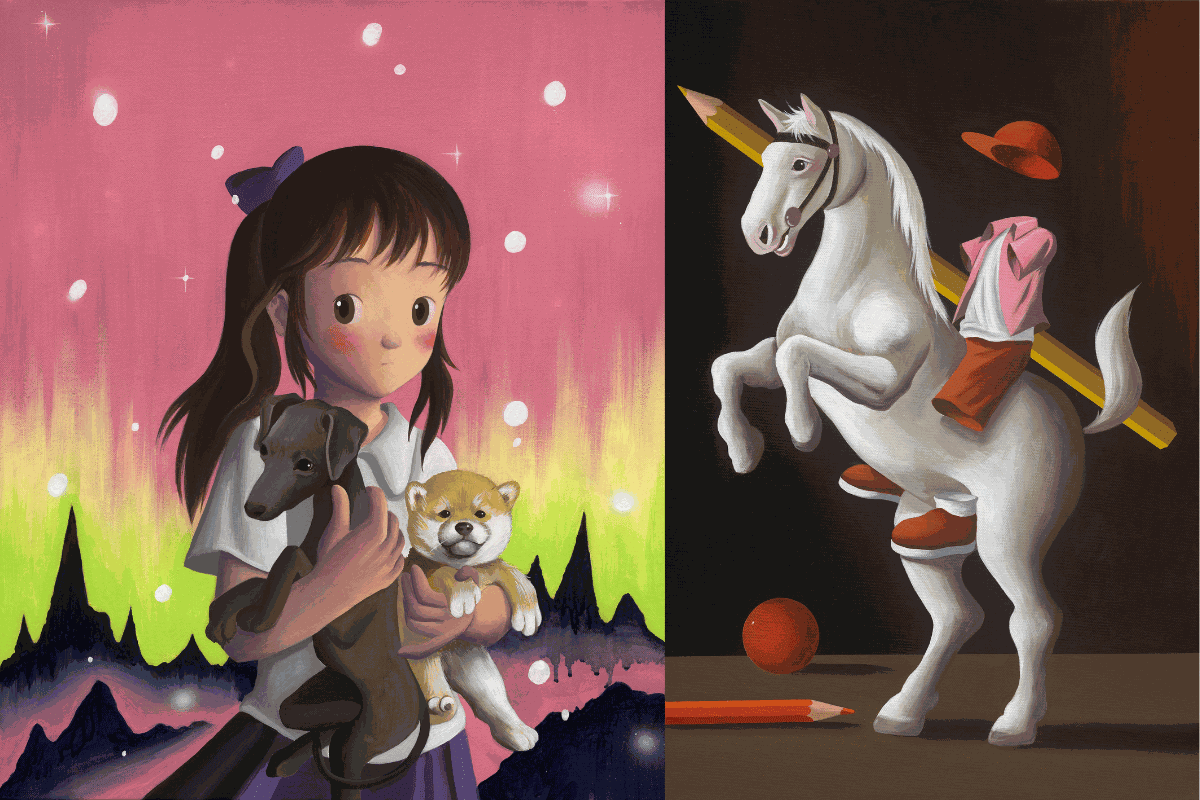
Hard-Boiled Wonderland (50 x 60 cm) & The Nonexistent Knight by Cheng Cheng Yi (40 x 60 cm), 2022
In the past, pink was exclusively a masculine color, softer than red. It was a socially acceptable color and there is ample evidence of this in art. Even in the Middle Ages, pink was primarily worn by men. In paintings, we find saints depicted wearing tunics or drapes in shades of pink.
Since pink was considered a shade of red (a strong and masculine color), it was associated with males, while blue was associated with females, being a more delicate hue. Blue was the color used for the veil of the Madonna and was more commonly used for dressing little girls.
Between the 13th and 14th centuries, pink represented the pigment of the body of Christ, a detail evident in depictions of the infant Jesus, clothed in pink, in the paintings of artists like Cimabue and Duccio di Boninsegna.
In the early 1400s, Venetian merchants began importing a dye known as "redwood" from Asia. For the first time, European dyers were able to fix various shades of pink on fabric. Since then, Venetian and later Italian courts competed to acquire fabrics of this color. Soon after, the fashion trend spread to France as well.
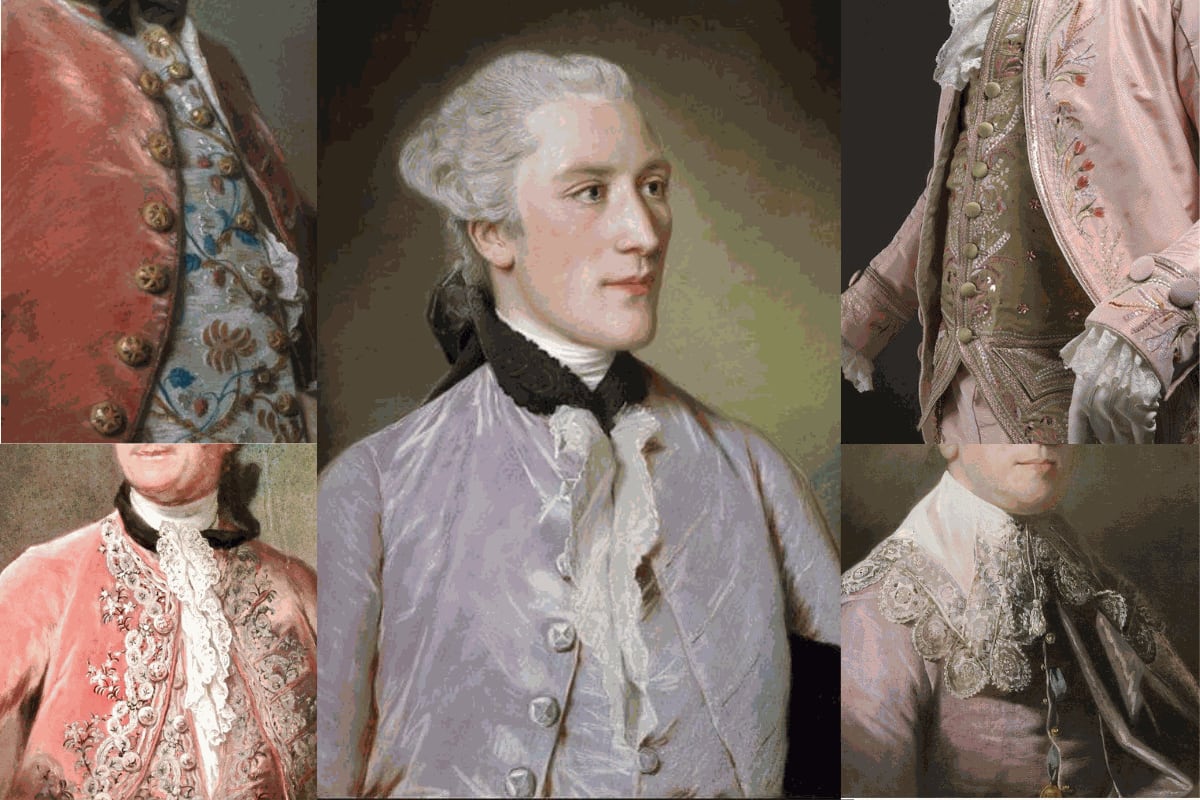
A selection of 18th century men portraits in pink suits
With the discovery of America, it was found that Brazil was home to an exotic wood, similar to "redwood" but more efficient as a dye plant and cheaper due to the free labor of slaves working in the plantations. Consequently, the trend for the color pink continued to expand. This expansion coincided with a growing fascination among European aristocracy for delicate colors and pastel tones. Moreover, the word "pink" first appeared in the 1700s, a period when not only men wore it but also used it, paired with white, for the interiors of their homes.
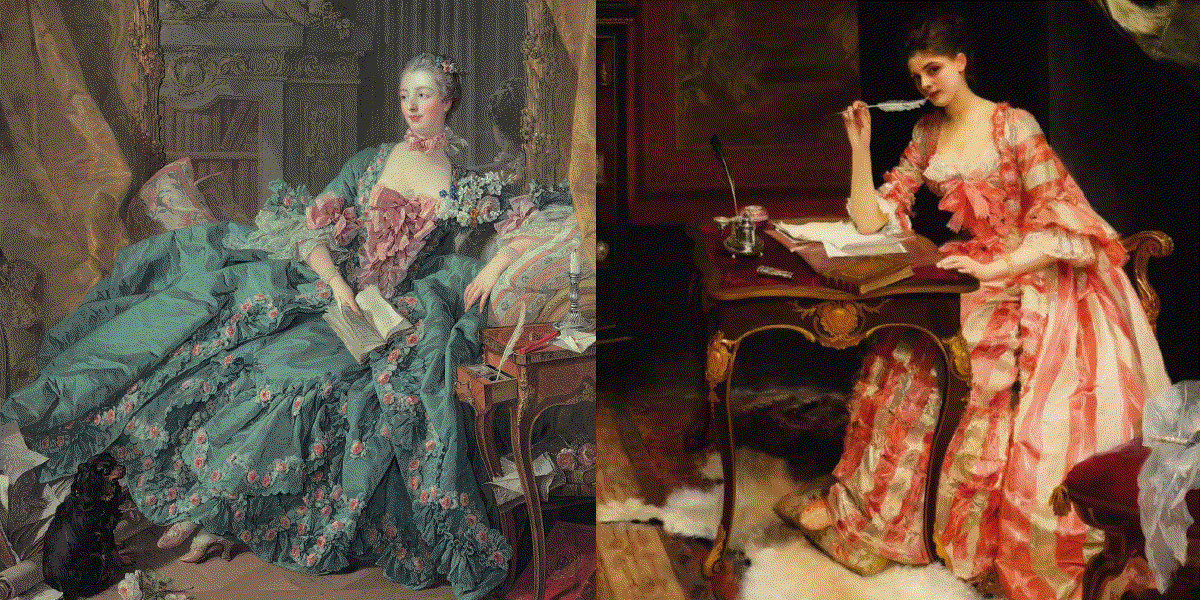
Madame de Pompadour by François Boucher, 1756 | The Love Letter by Gustave Jacquet, 1883
In the 1700s, pink was very fashionable and was worn by both men and women, who wore subtle and dusty variants of the color as a symbol of luxury and class.
Particularly enamored with these shades was Madame de Pompadour, the Marchioness of Pompadour, who played a significant role in popularizing the fashion for pink in 18th-century Europe. Madame de Pompadour, an art and science patroness, as well as the favorite of Louis XV, loved this color so much that in 1757, the French porcelain manufacturer Sèvres named their beautiful new shade of pink "pink Pompadour" in her honor.
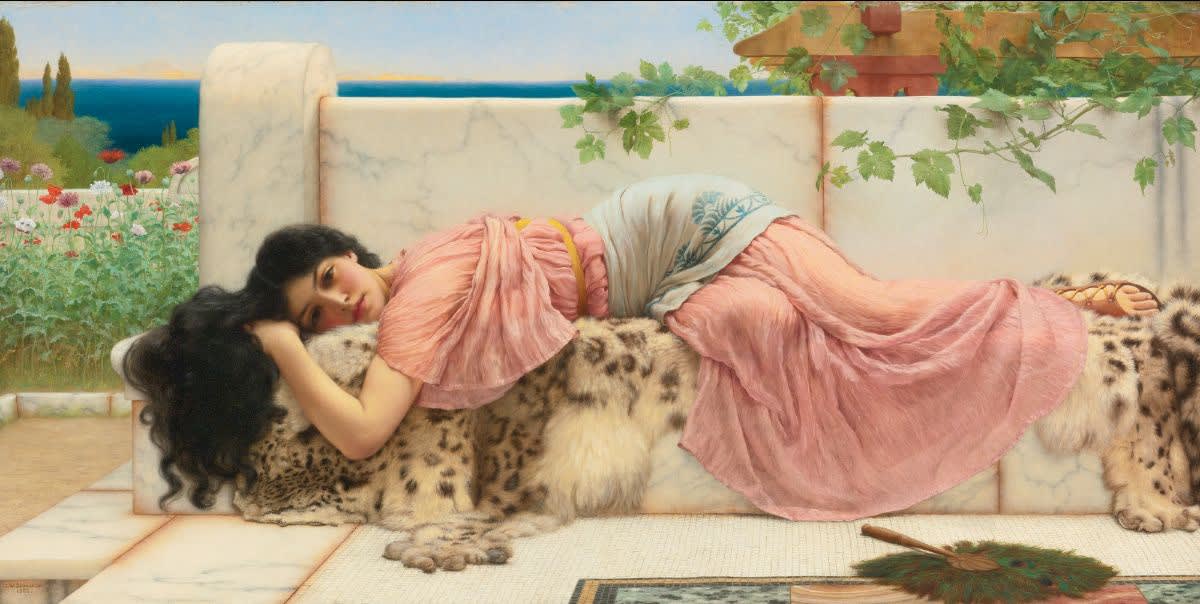
When the Heart is Young by John William Godward 1902
Until the 1800s, the color pink was considered appropriate for men. It was only in the early 1900s that we find the first references to color being assigned to gender. Until the early 1900s, pink continued to be present in everyone's wardrobes, as evidenced by the famous "pink suit" imagined by Fitzgerald for the protagonist of his renowned novel "The Great Gatsby."
However, in the early 1930s, men began predominantly wearing dark clothing, considered more serious and suitable for professional settings. Women, on the other hand, started wearing light and delicate tones, associated with the family and domestic sphere.
Even children's clothing began to be differentiated at younger ages, following the growing popularity of Sigmund Freud's theories about sexuality and gender distinction. Until World War II, pink and blue were still interchangeable.
After the Nazi persecutions, men abandoned the color pink. In fact, anyone accused of homosexuality was sewn into a large pink triangle to make them easily recognizable. Since then, pink became associated with effeminacy or the female gender. For this reason, the pink triangle has become a symbol of the modern LGBTQ+ rights movement.

Zsa Zsa Gabor wearing a gown by Schiaparelli in Mouline Rouge (1952) & the perfume Snuff by Schiaparelli
"The color appeared before me, in a flash. Vibrant, impossible, audacious, full of life, captivating, as if all the lights, birds, and fish in the world merged together, a color that spoke of China and Peru, far from the West. A shocking, pure, and concentrated color."
Elsa Schiaparelli
Simultaneously with these events, chemistry managed to create a new shade of pink, now the most famous: "shocking pink". Designer Schiaparelli made this color her signature, definitively turning pink into a symbol of womanhood.
In the 1950s, a specific assignment of colors became established. Since then, pink has been identified as the quintessential feminine color. Pink ended up being associated with women and became ubiquitous, not only in clothing but also in consumer goods.
In the late 1950s, the famous Barbie doll was introduced to the market, further solidifying the trend of pink associated with the female gender. Today, pink is deeply rooted in our imagination as a feminine color and has gained undeniably strong communicative power.

Rosie's Tea Party (2005) & Pink Pop Barbie (2022) by Mark Ryden
PINK IN ART HISTORY
Pink appears as early as the 13th century, albeit in a subtle manner, in the tempera works of great medieval masters such as Duccio and Cimabue. They used a light shade of pink for the draperies enveloping the body of the Baby Jesus, in accordance with the chromatic symbolism associating pink with the body of Christ.
During the Middle Ages, pink was not widely used, but it occasionally appeared in religious art and women's fashion. The color gained a more prominent position in artists' palettes during the Renaissance. It became a subject of artistic treatises and was systematically used to paint the skin tones of hands and faces.
The pink pigment used during that time was called "cinabrese chiaro," a mixture of a white or chalk white pigment and a red earth pigment called "sinopia." Cinabrese chiaro was highly popular and favored by many renowned Renaissance artists such as Cennino Cennini and Raphael, who incorporated it into their paintings.
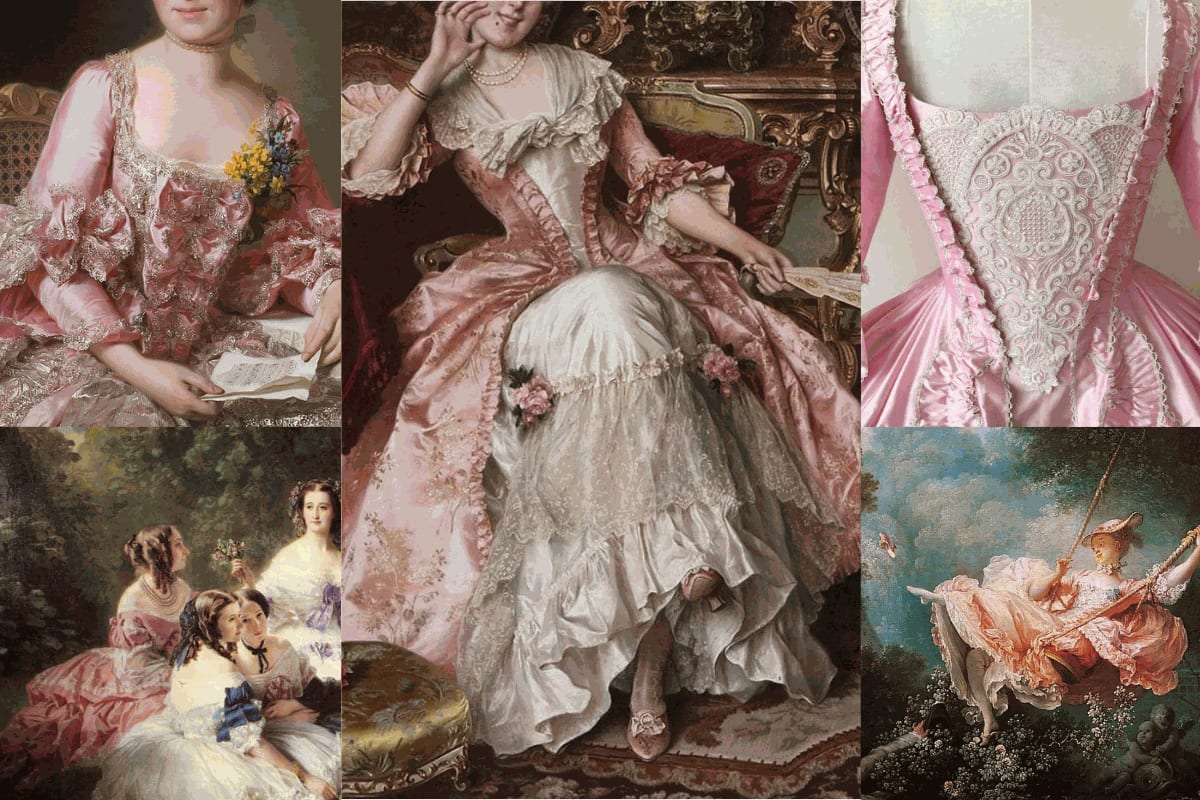
Selection of 18th century pink gowns
"The worldly culture and the worship of beauty transform the solemn splendor of the Baroque into the lightness of the Rococo; in art, there is room for a fairy-tale disorder, where curved lines and asymmetry triumph, slender forms and delicate nuances prevail. Decoration continues, layered, but no longer affects the structure; instead, it becomes a mere calligraphic description."
Fabrizio Casu (Il lungo viaggio di una chemise)
Between the 17th and 18th centuries, during the evolution from Baroque to Rococo aesthetics, the significance and prevalence of the pink hue gradually increased.
The golden age of the color pink occurred during the Rococo period (1700-1774), when pastel colors became highly fashionable in European courts. In the visual arts of the 1700s, pink became a trendy color. The shade introduced by the Venetian painter Giambattista Tiepolo, in particular, gained widespread appreciation and appeared in many of his works.
Quoting Fabrizio Casu, author of the book "Il lungo viaggio di una chemise": "Paintings featured airy, soft, and voluptuous images by Boucher, and later, Honoré Fragonard inaugurated, through genre scenes, a coquettish taste characterized by merriment, amusement, and amorous banter".
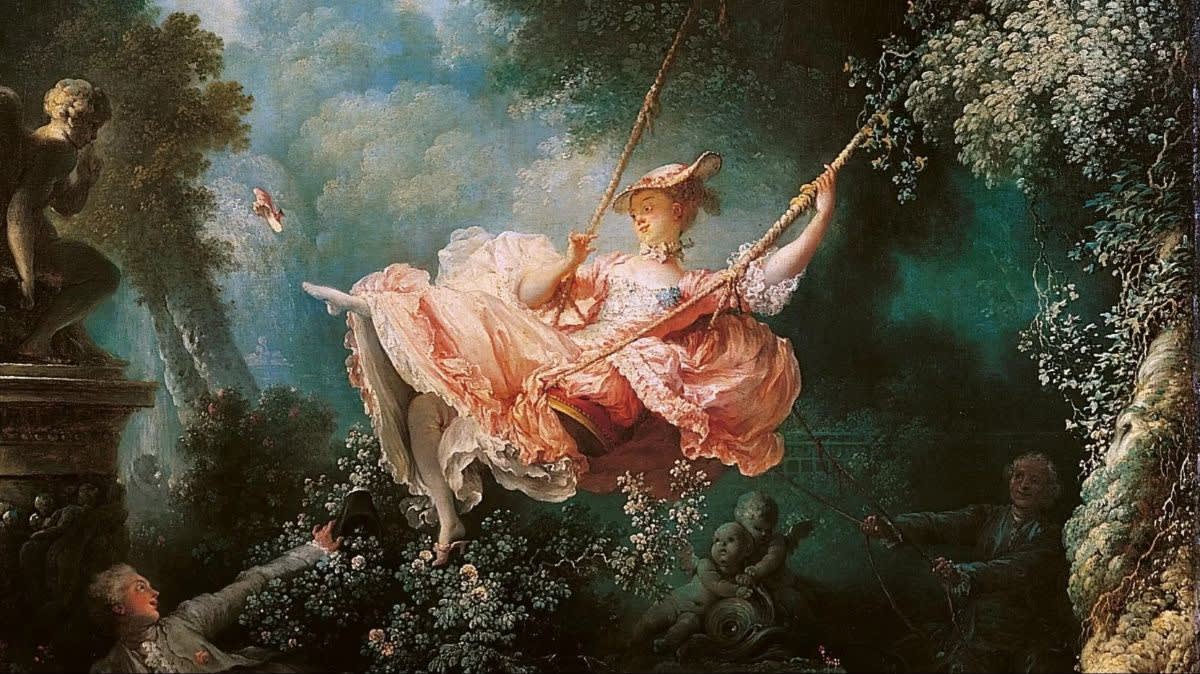 The Swing by Jean Honoré Fragonard, 1767
The Swing by Jean Honoré Fragonard, 1767
The works of Jean Honoré Fragonard (1732-1806) are emblematic and exceptionally beautiful, characterized by rosy tones not only in women's attire but also in the splendid landscapes. Pink was also used as a color associated with the idea of seduction in portraits of Lady Hamilton and Emma painted by George Romney.
However, this meaning changed towards the end of the 1700s, notably with the famous portrait of Sarah Moulton created by Thomas Lawrence. In this artwork, pink symbolized childlike innocence and tenderness. Since then, pink became associated with the concepts of femininity, purity, and innocence.
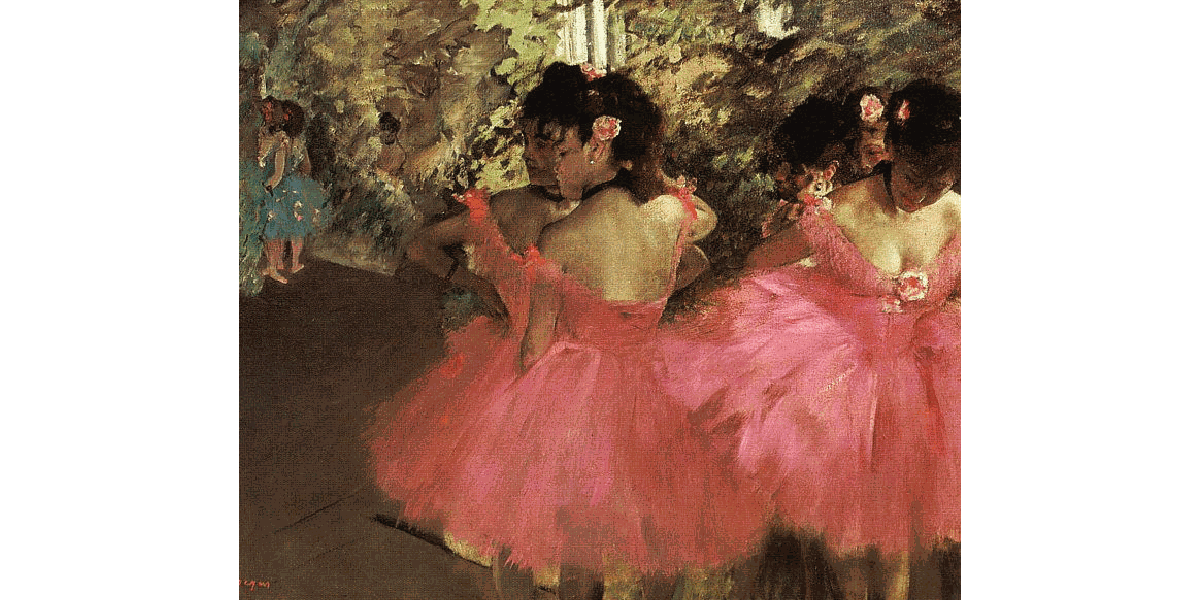
Dancers in Pink by Edgar Degas, 1867
In the 19th century, with the Impressionist and Post-Impressionist movements, coupled with Oriental influences, pink was consecrated as a fundamental color in compositions, often combined with green and blue. A splendid example of this can be seen in Edgar Degas' ballerinas, particularly in his 1867 artwork, where various ballerinas are captured in pastel pink dance costumes, representing an 'instantaneous' moment.
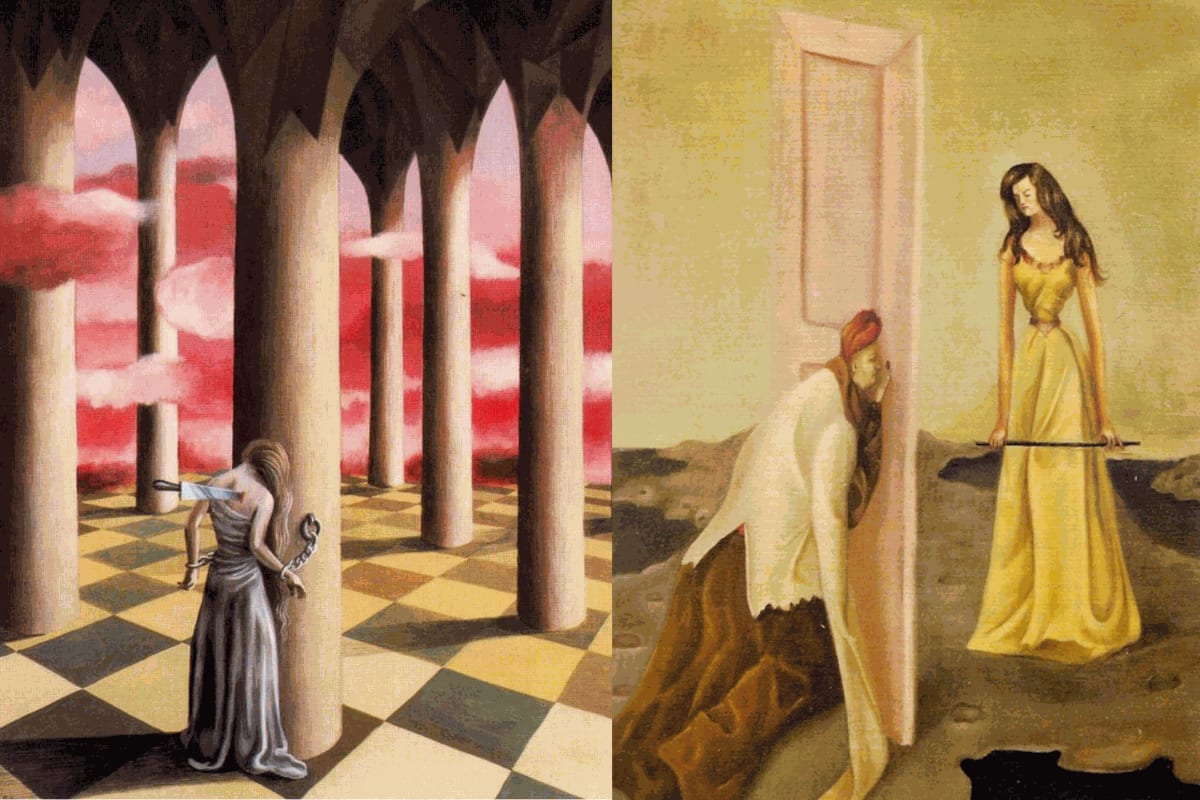
Rheumatic Pain by Remedios Varo, 1948 & The Curious by Leonor Fini, 1936
In the 20th century, there was a certain inconsistency regarding the use of the color pink in art. Within the historical avant-garde movements, such as Surrealism, Dadaism, and Expressionism, which were dominated by strong male personalities, there was little space for delicate and now perceived as feminine shades like pink. However, there are exceptions where pink dominates or is present in incredibly beautiful and suggestive works, including "Rheumatic Pain" by Remedios Varo and "The Curious" by Leonor Fini, two of the most important female surrealists of the 20th century.
Additionally, there is the exception of Picasso's Rose Period, dating back to the early years of the century, during which the artist created works in warm tones, reflecting a joyful period in his life.
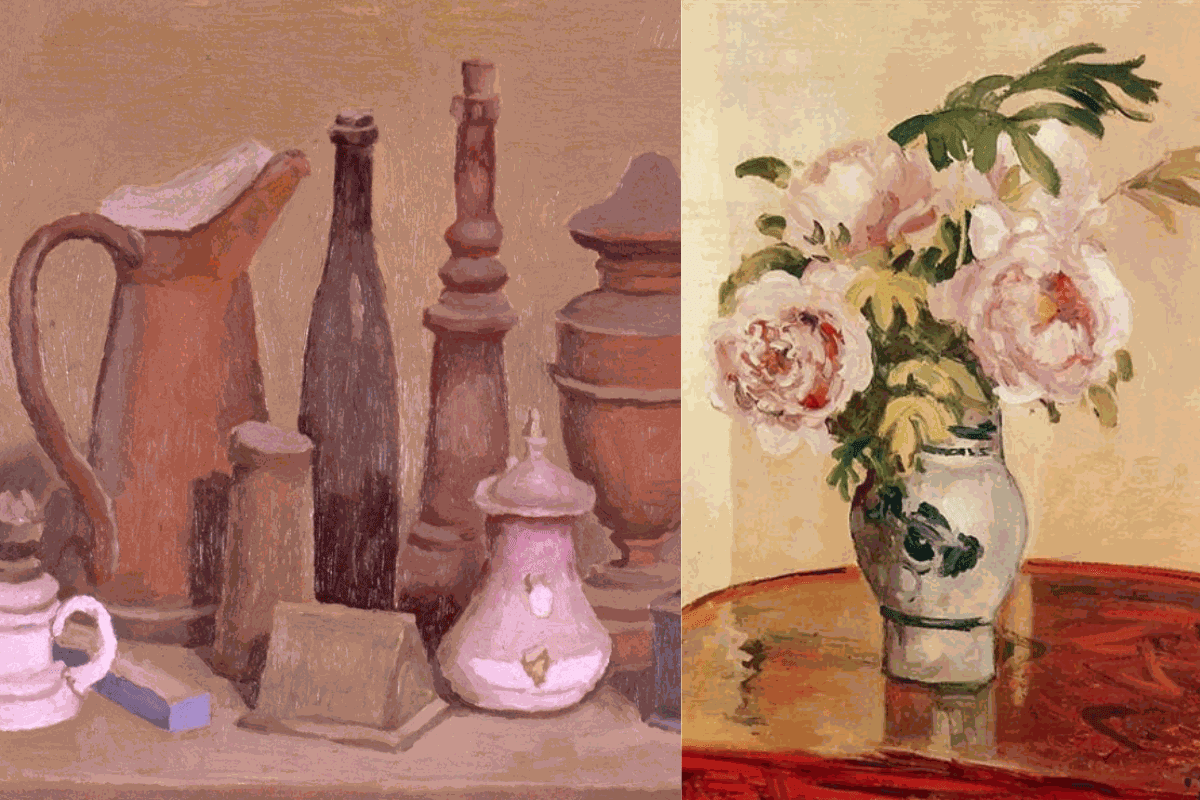
Natura Morta by Giorgio Morandi 1929 & Pink Peonies by Camille Pissarro, 1873
Pink regained prominence with the advent of Pop Art, which focused on incorporating consumer society iconography into artistic language. In the contemporary art landscape, there is a trend towards a more liberated use of the color pink. It appears in the works of various artists, both abstract and figurative, with and without symbolic meanings.
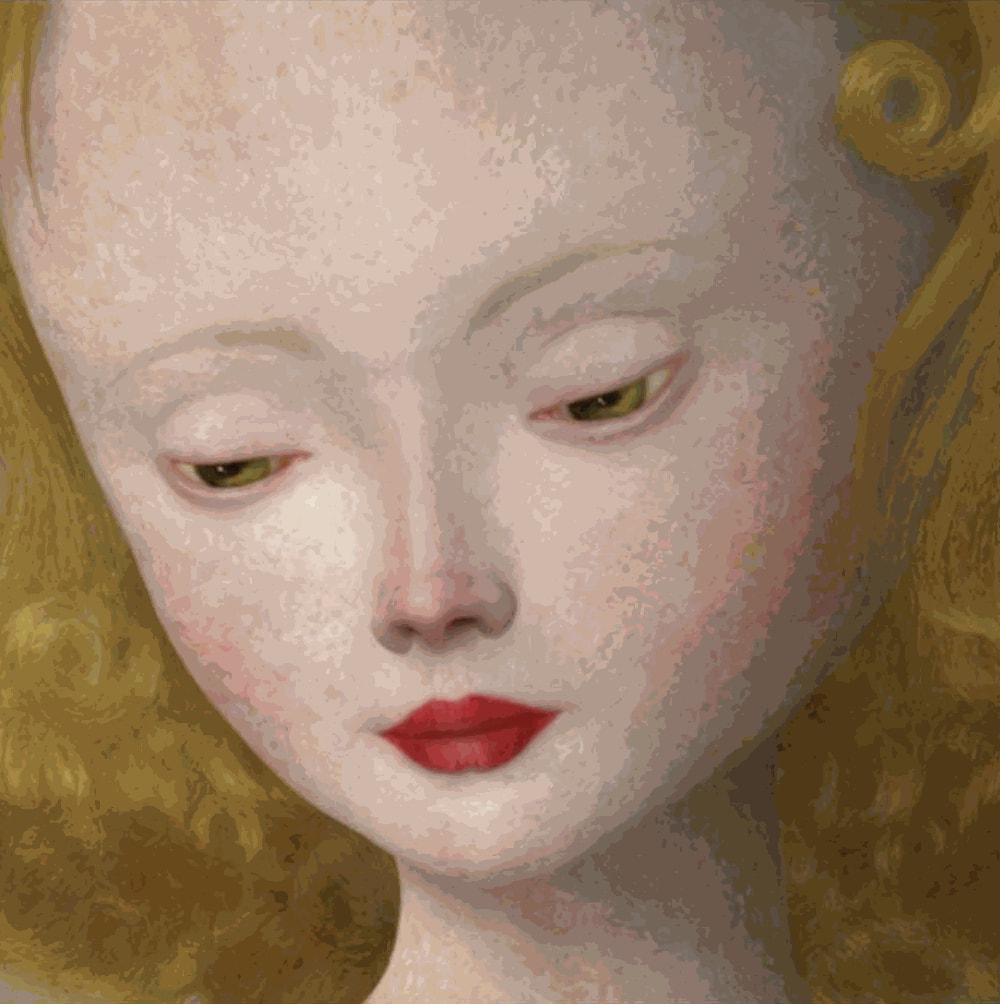
Blessed Fragment by Ray Caesar, 2019
One of a Kind Digital Ultrachrome & Acrylic on Wood Panel (20 x 20 cm)
A FOCUS ON THE EIGHTEENTH CENTURY: FEMMINITY AND THE POWER OF WOMEN
The 18th century is rightfully called the "century of femininity" by many, not because it achieved true equality, but because it marked the beginning of women's emancipation from male authority. This movement eventually paved the way for significant civil rights struggles in the 19th century.
By delicately stepping into spaces previously left vacant or unguarded by masculinity (such as education, culture, political participation, and private spheres), women laid the groundwork to later assert a louder voice and claim a more substantial role in public life.
The Enlightenment society believed in the importance of reforming female education, starting primarily with the choice of educational institutions. Criticizing the inadequacy of convents, there was a push for domestic education "à la Rousseau." However, since this kind of education could only be received in privileged environments, an alternative proposal was made: a system of public education based on secular institutions. In 1709, feminist Mary Astell founded a school for underprivileged girls in London as an alternative solution.
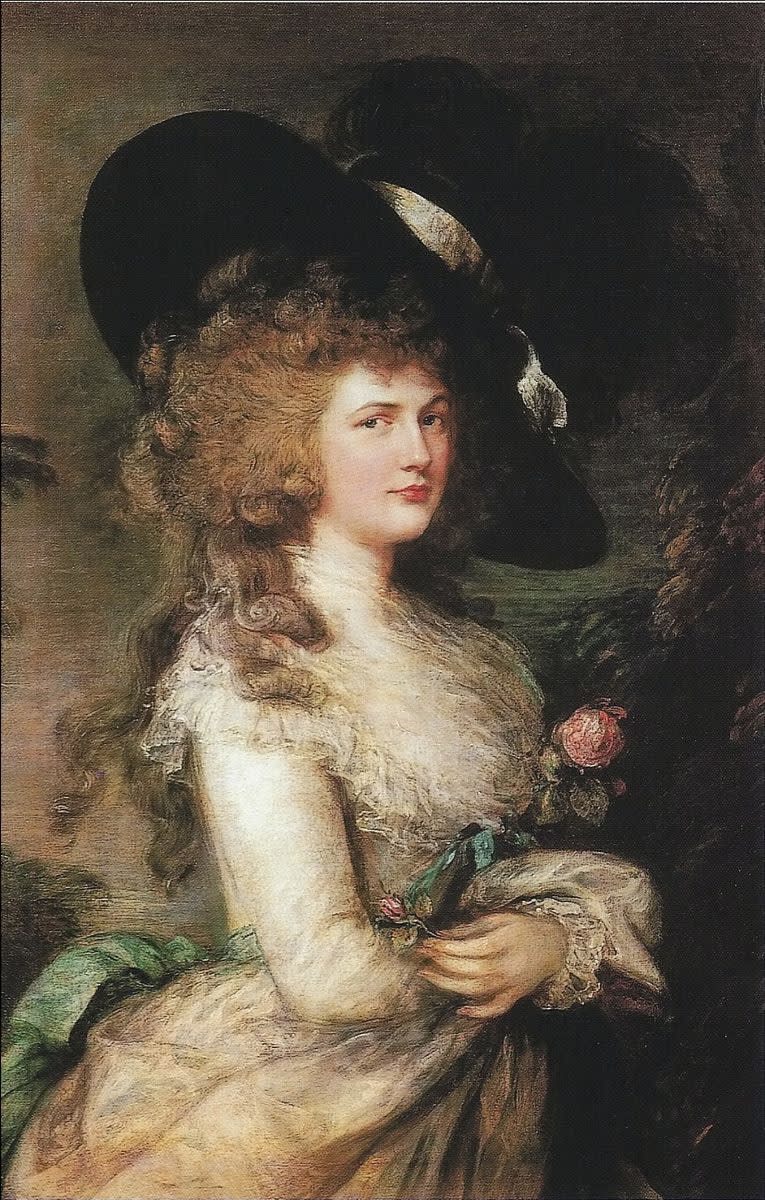
Portrait of Georgiana, Duchess of Devonshire by Thomas Gainsborough, 1787
There are indeed other significant examples of women who emerged due to their intelligence and avant-garde thinking. The newspaper "Epistles for Ladies" (1749-1750) encouraged girls to use microscopes and explore microorganisms.
Laura Bassi (1711-1778) from Bologna became the first woman to earn a doctorate in physics. Duchess Georgiana of Devonshire (1757-1806) amassed a museum-level collection of fossils and minerals at her residence in Chatsworth. Marchesa Emile du Chatelet (1706-1749), Voltaire's companion, translated Newton's mathematical principles into French.
Even in the realm of luxury goods, femininity managed to establish its autonomy. By combining creativity and design, women anticipated the 20th-century figures associated with fashion design, hairstyling, and image consulting.
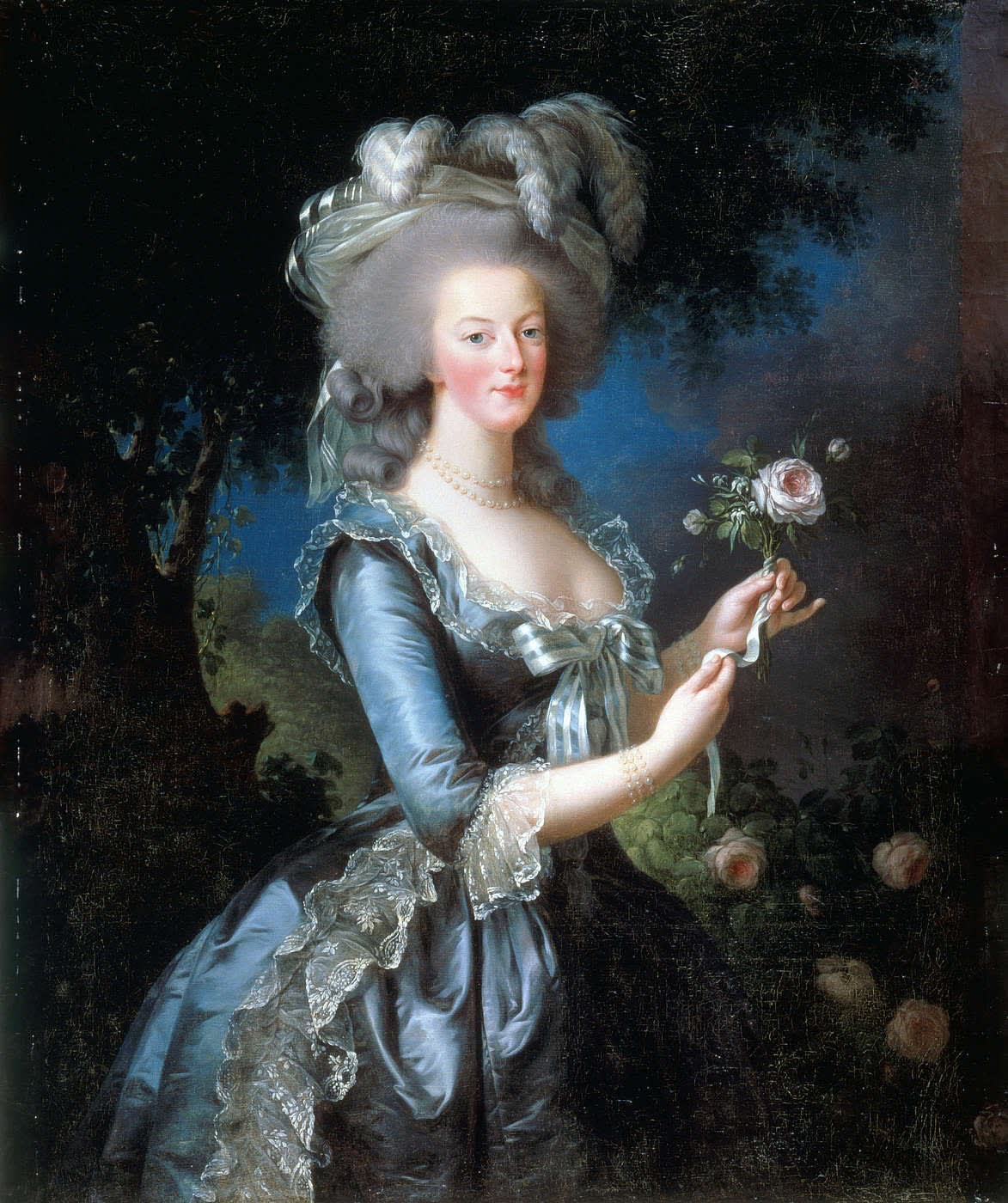
Marie Antoinette by Madame Vigée Le Brun, 1783
As paradoxical as it may seem, even Marie Antoinette embodies the ongoing feminine change in this context. Between the intellectual revolution initiated by the Enlightenment and the factual revolution that erupted in 1789, she unwittingly advances a revolution in manners. She staunchly defends the value of self-determination, starting with choices that might seem trivial to us: what to wear, whom to love, where to live, how to educate her children, whom to socialize with, when to engage with others, and when to withdraw into her own privacy.
Serving as a bridge between tradition and modernity, protocol and spontaneity, public life and private life, the Queen of France becomes the first terrorist of her reign. She herself shatters the social cohesion system based on form, which guarantees her authority and personal security. Reckless, lively, and instinctive, she is unaware that this behavioral rebellion, born from a generational intolerance for rules, will slip from her grasp and extend far beyond the boundaries she set, becoming a mere accessory to a much more radical evolution.
[Source:Il lungo viaggio di una chemise by Fabrizio Casu]

John Smart - portrait miniatures 1760 ca. Portraits of Ladies with hair worn curled and pink powdered and decorated with silk ribbon and pearls.
The European Fashion Landscape: During the peak of wigs’ popularity, some wearers opted to powder their hairstyles pink, a drastic change from the usual silver or grey. This was a striking departure from convention, and one whereby the wearer stood out as a beacon of largesse and extravagance.
Go back in time and explore the fascinating world of 18th-century hair fashion with these portraits. In the video below, we delve into the elaborate and extravagant hairstyles that defined an era. These powdered poufs were not just a fashion statement but also a symbol of social status and identity.
PINK ME UP: THE PRAISE OF PINK
For the second participation at Art Taipei, Dorothy Circus Gallery will present "Pink Me Up", a collective exhibition that celebrates art as a universal language, capable of transcending time and space, offering healing, inspiration, and boundless joy. Focused on the transformative power of the color pink, this exhibition features eight exceptional artists, each with their unique perspectives.
The artists to be featured are: Joe Sorren, Fatima Ronquillo, Afarin Sajedi, Kazuki Takamatsu, Paolo Pedroni, Alex Face, Hanna Lee Joshi, and Peca.

The Critic (60 x 76 cm) & Mother and Child (60 x 90 cm) by Joe Sorren, 2023
This exhibition project explores the fascinating world of color psychology, focusing on the influence of pink on our mood and emotions. The goal is to analyze how the color pink can evoke feelings related to love, kindness, warmth, and creativity.
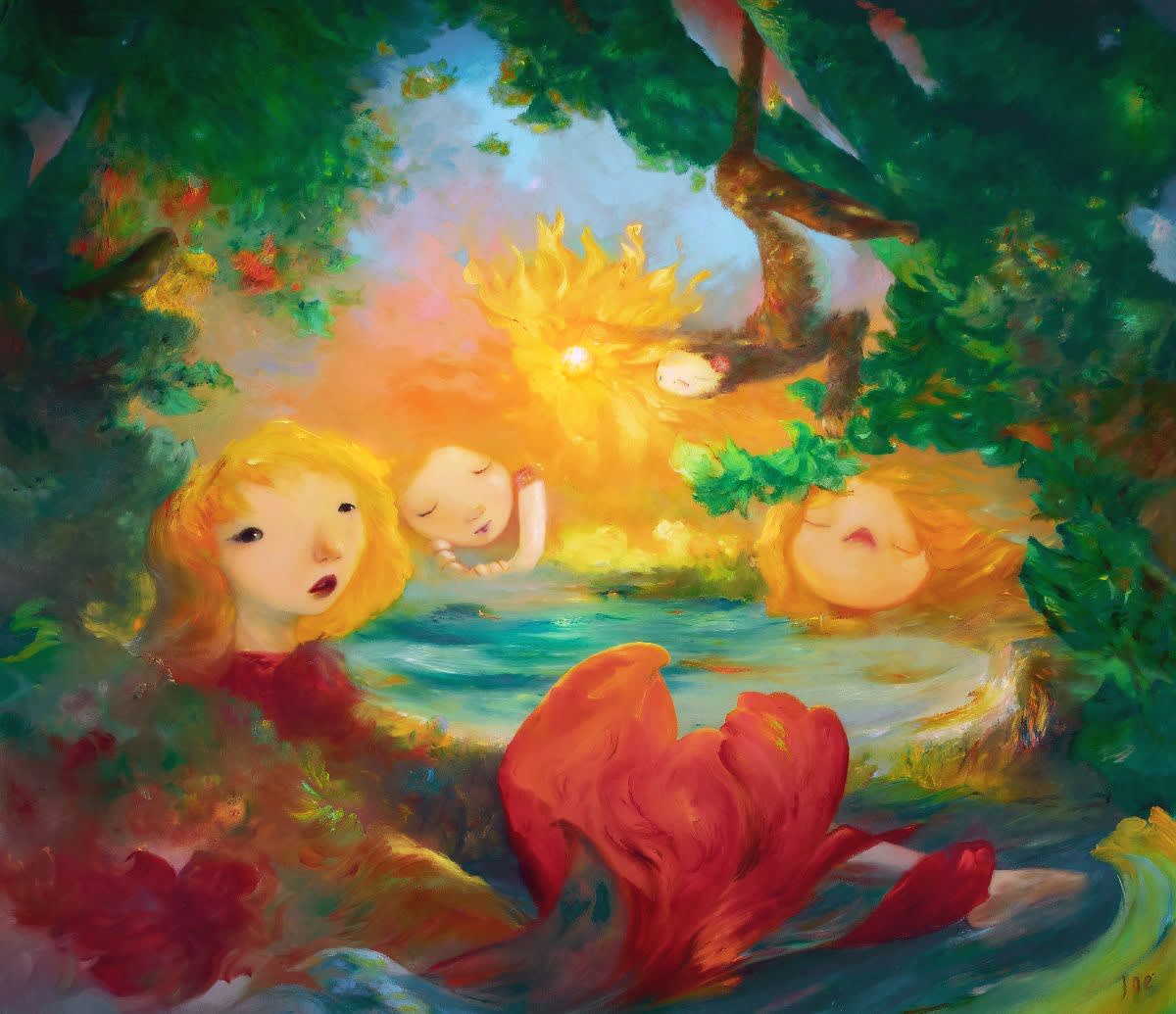
A Scare-Up at the Sun Within by Joe Sorren (156 x 170 cm), 2023
Joe Sorren, an American pop surrealist with a unique impressionistic style, will present evocative works capturing the extraordinary and majestic beauty of the natural world. Through delicate touches of pink hues, Sorren's paintings reveal hidden reflections, transporting us to serene landscapes exuding joy and tranquility. These works remind us of the healing and transformative power of nature on our psyche, inviting us to immerse ourselves in its beauty and find inspiration in its grandeur.
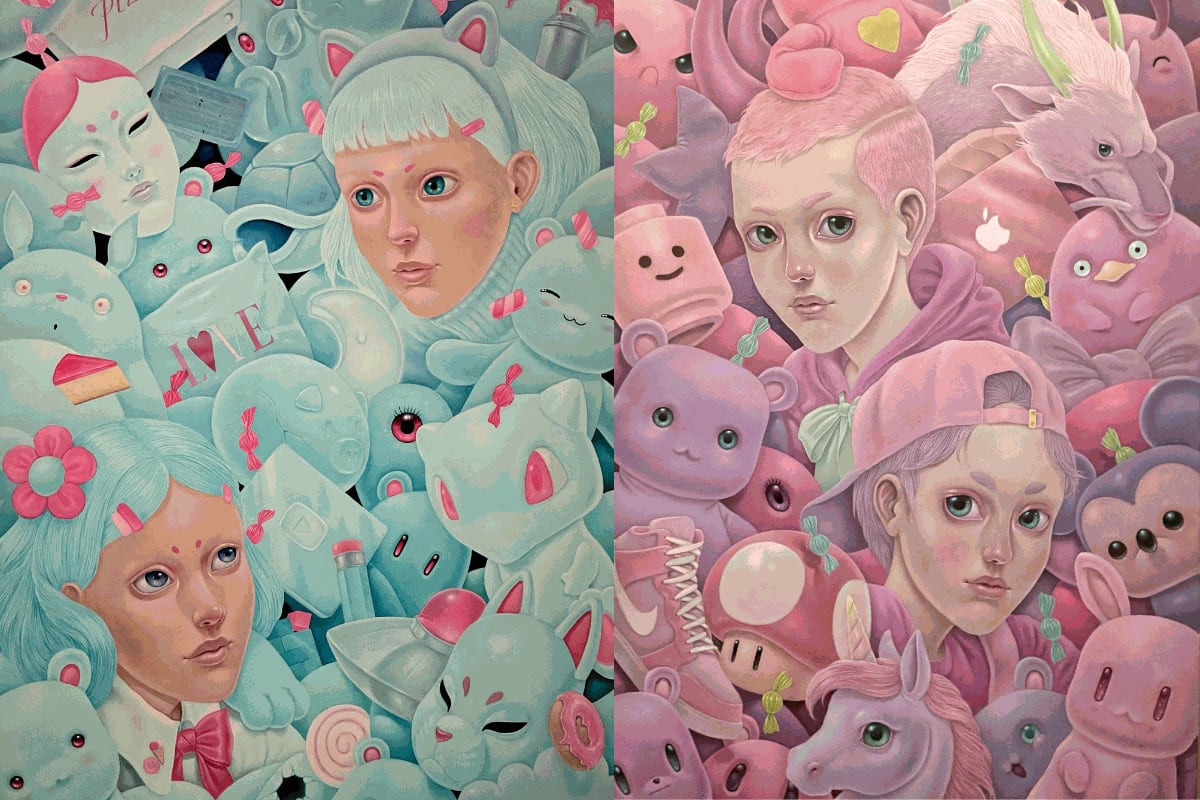
Floating (100 x 150 cm) & Pink Fever (100 x 150 cm), 2023 by Paolo Pedroni
Paolo Pedroni, an Italian magical surrealist, presents works that skillfully blend the boundaries between reality and dream. Through pink hues infused with symbolism and mystery, his paintings invite us to explore deep feelings related to friendship and love. This powerful color acts as a magnifying lens, amplifying and bringing to light the complex emotions associated with these relationships.
In particular, the artist showcases works where the sense of horror vacui emerges with great force. All three pieces he has created for this exhibition are rich in intricate details and vibrant pink tones.
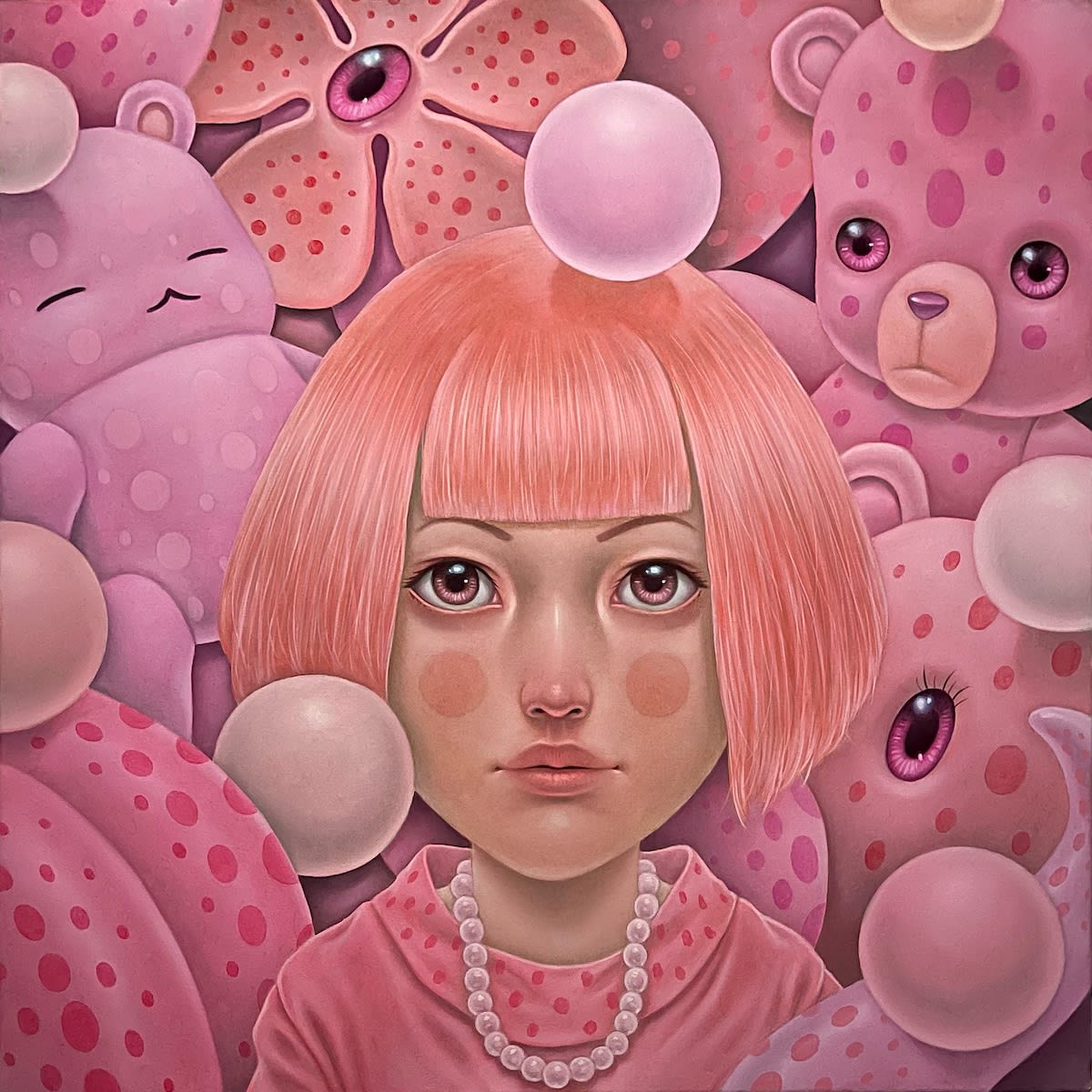
Baby Kusama (60 x 60 cm) by Paolo Pedroni, 2023
One of his works, "Baby Kusama", is not only a tribute to an extraordinary artist but also a testament to the transcendent power of art itself.
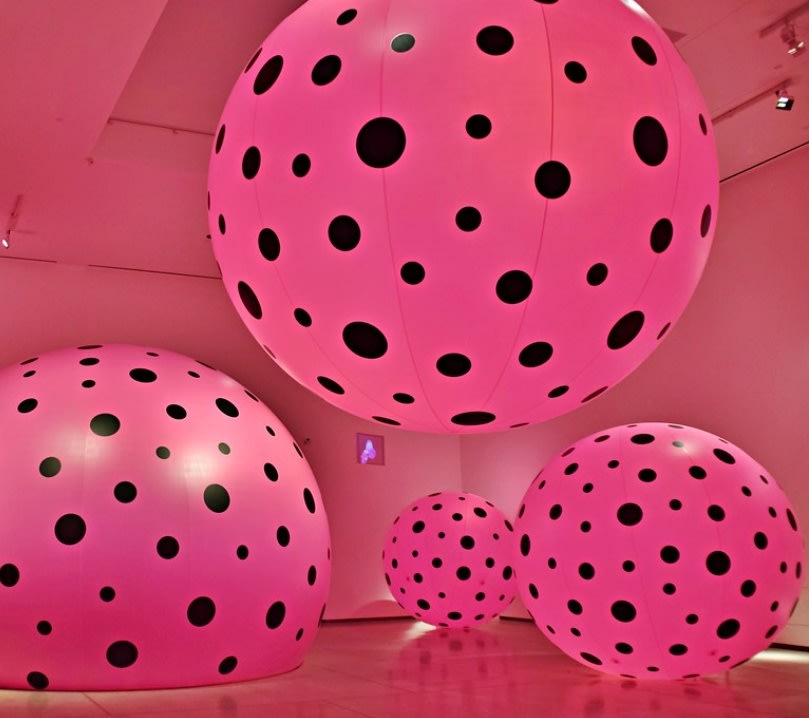
Dots Obsession- Love Transformed into Dots by Yayoi Kusama, 2007
This pink-themed exhibition also features enchanting floral bouquets by Thai artist Alex Face. His works are inspired by the 17th-century "Vanitas" and are infused with contemporary symbolism of life's transience. These masterpieces, drawing inspiration from the various shades of flowers, take us on an emotional journey through nature's secret language. Alex Face's works illuminate secrets and memories with an evocative and cathartic power, inviting us to reflect on life's ephemeral beauty and its eternal connection with the surrounding nature.
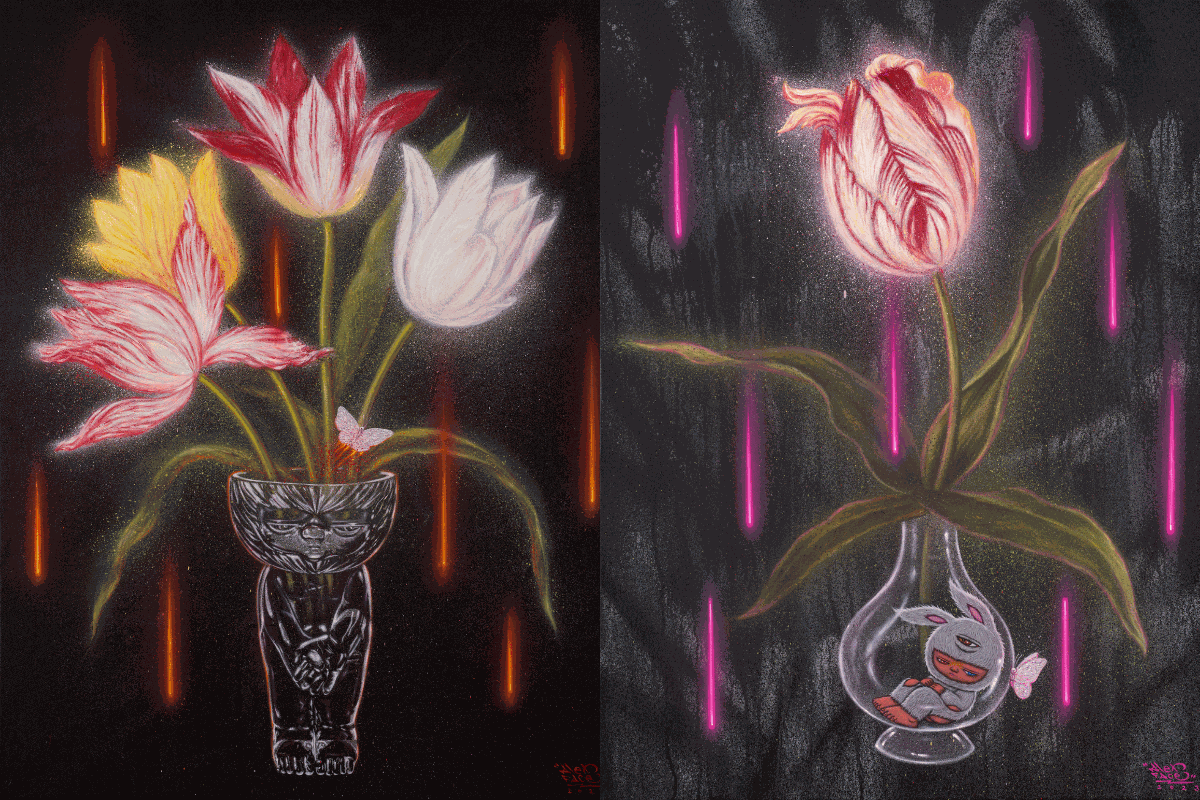
Tulip Mania No. 1 (90 x 70 cm) & Tulip Mania No. 2 (85 x 65 cm) by Alex Face, 2023
Shades of pink can also be found in the shifting hues of Japanese artist Kazuki Takamatsu's works. Takamatsu's art, rich not only in technical prowess but also in symbolism, invites us to confront the complexity of the relationship between humans and technology, stimulating our minds and inspiring us to consider our impact in the modern world. His spectral and utterly fascinating visions are like whispers in the wind, wandering laden with emotions and feelings.
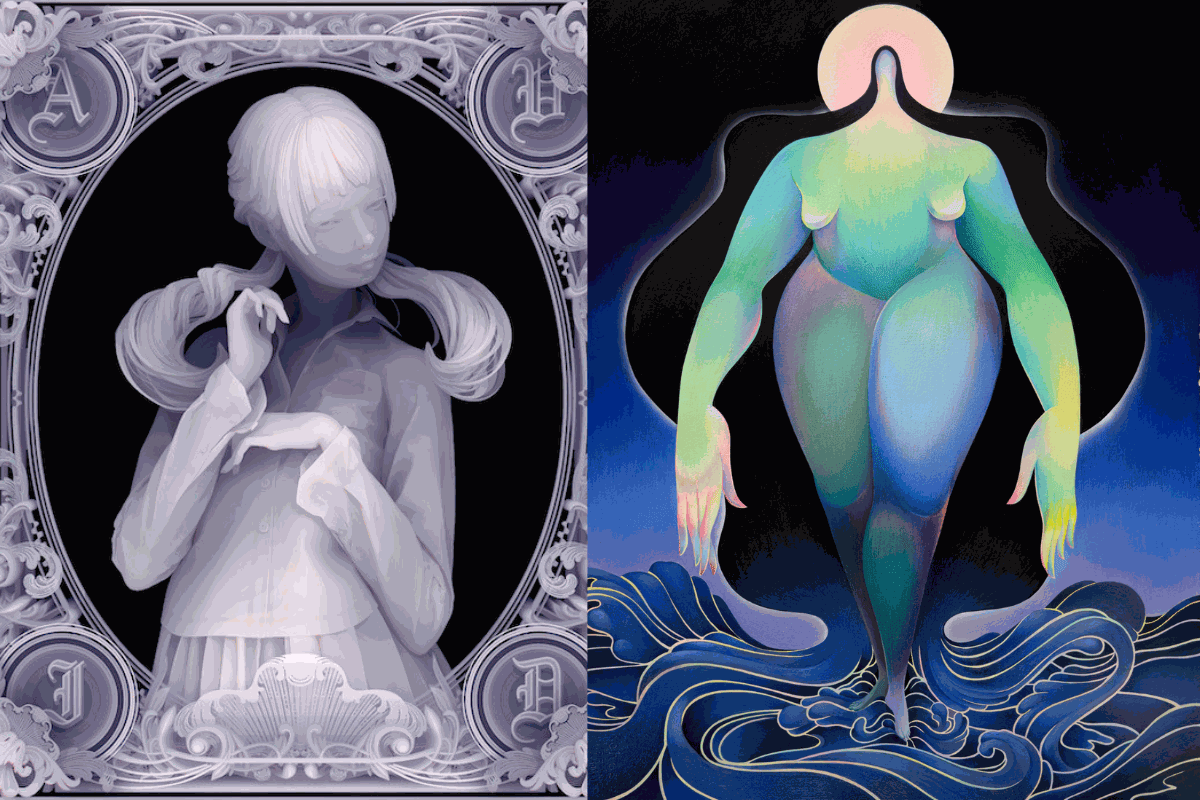
Avid by Kazuki Takamatsu (53 x 45.5cm) & Light will catch you by Hanna Lee Joshi (57.15 x 76.2 cm), 2023
“Part of the inspiration for this piece came from an inner seeking of stillness. A desire to just be and take up space. Like a deep sigh that releases all inherent tensions within and without. I wanted to create something embodying this state of being.”
Hanna Lee Joshi
Hanna Lee Joshi welcomes us into her enchanting universe, where bold shapes and vibrant colors, including shades of pink, merge to create a unique visual language. Through her extravagant and transcendent paintings, Joshi reminds us of the power of art to bring us joy and happiness, capturing the essence of the transformative nature of pink in our lives.
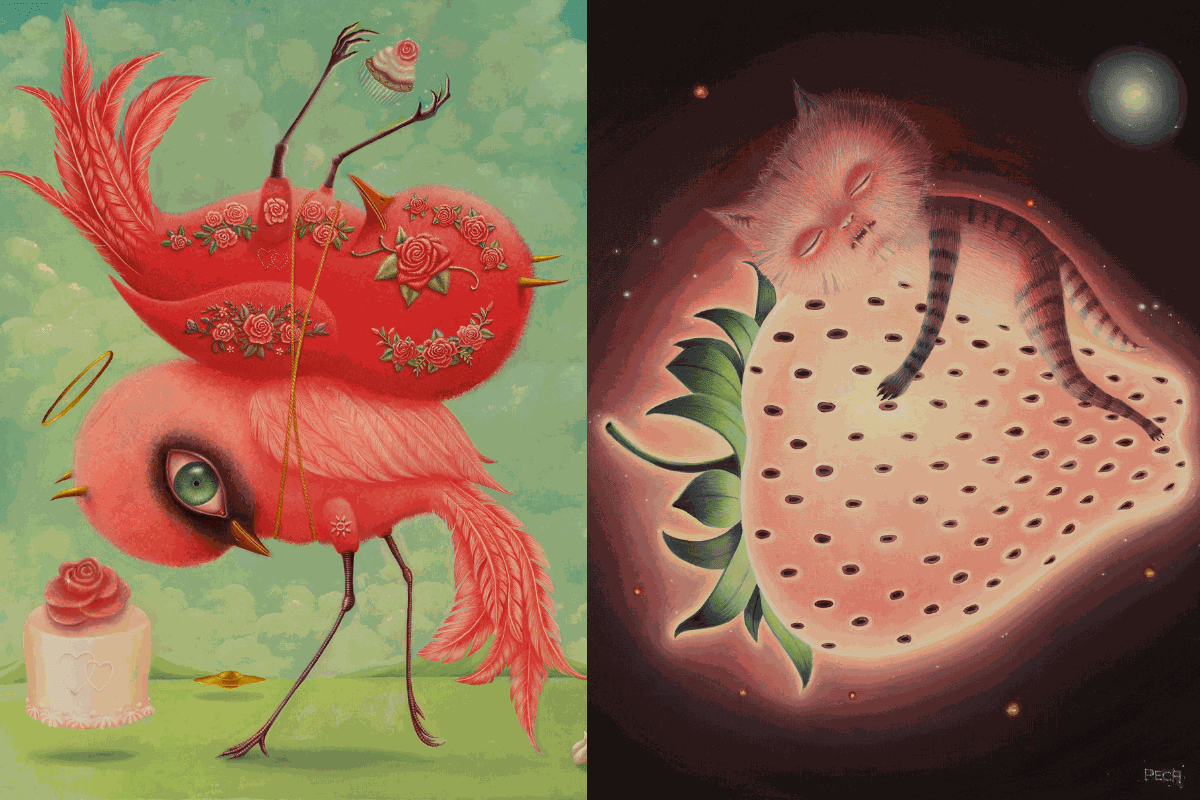
The Wedding Cake (100 x 80 cm) & Strawberry Feeling by Peca (55 x 46 cm), 2023
“I aim to explore of the synchronicities that bind kindred spirits. In every stroke, I unveil the invisible threads that weave through the tapestry of souls, connecting beings with a shared essence. It's a testament to the profound unity that exists within the universe.”
Peca
Peca, the Argentine surrealist painter, invites us to escape into a fantastical world dominated by imagination. With playfulness and visionary creativity, she draws inspiration from nature, particularly birds, creating art that embraces the pink color palette. Through her enchanting paintings, Peca encourages us to explore the boundary between reality and fantasy, urging us to dream and rediscover a sense of wonder in our everyday lives.
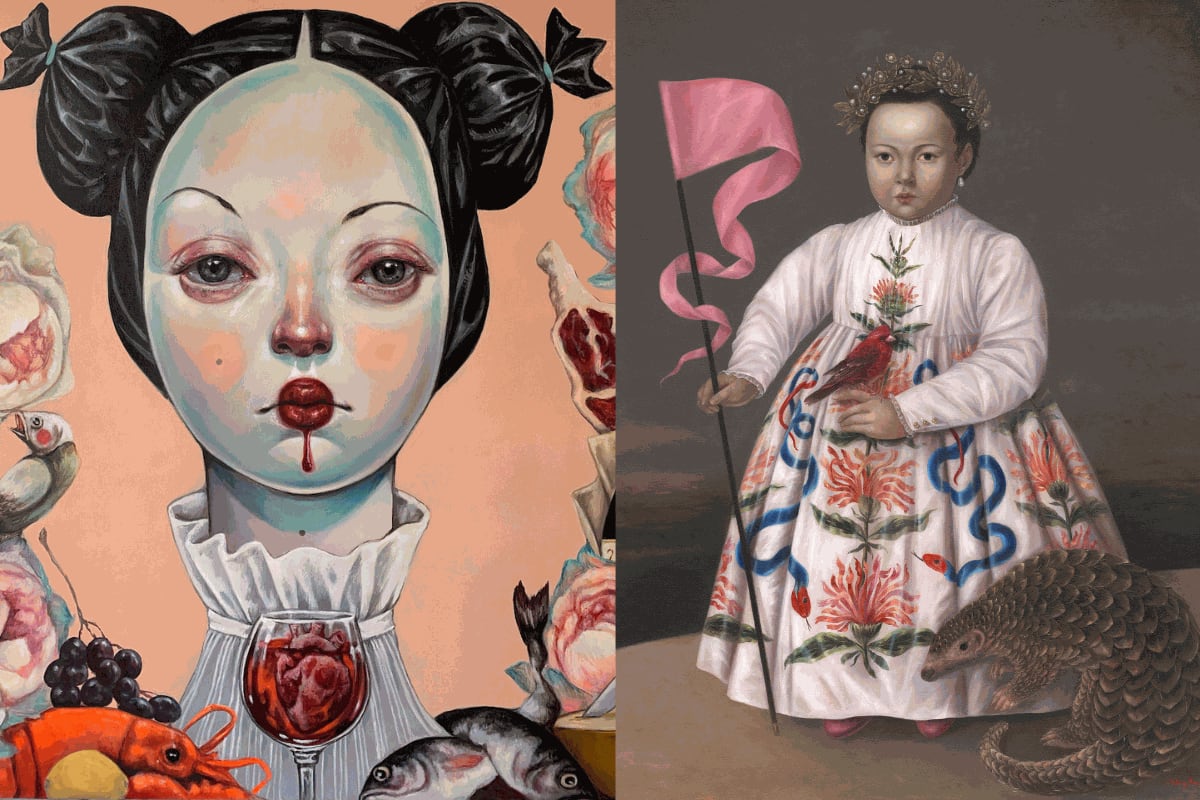
Bon Appetit (90 x 90 cm) by Afarin Sajedi & Pink Flag by Fatima Ronquillo (91.44 x 76 cm), 2023
“Pink Flag is a celebration of hope and resilience.Throughout, there is a sense of light and dark, of paradise lost and found.”
Fatima Ronquillo
Filipino-American painter Fatima Ronquillo transports us to a realm infused with the magical essence of art history. Her works, abundant with floral and bucolic details, introduce us to ethereal figures and enchanting creatures that awaken wonder within us. These paintings evoke a world where time and space are intangible, inviting us to explore new dimensions of existence.
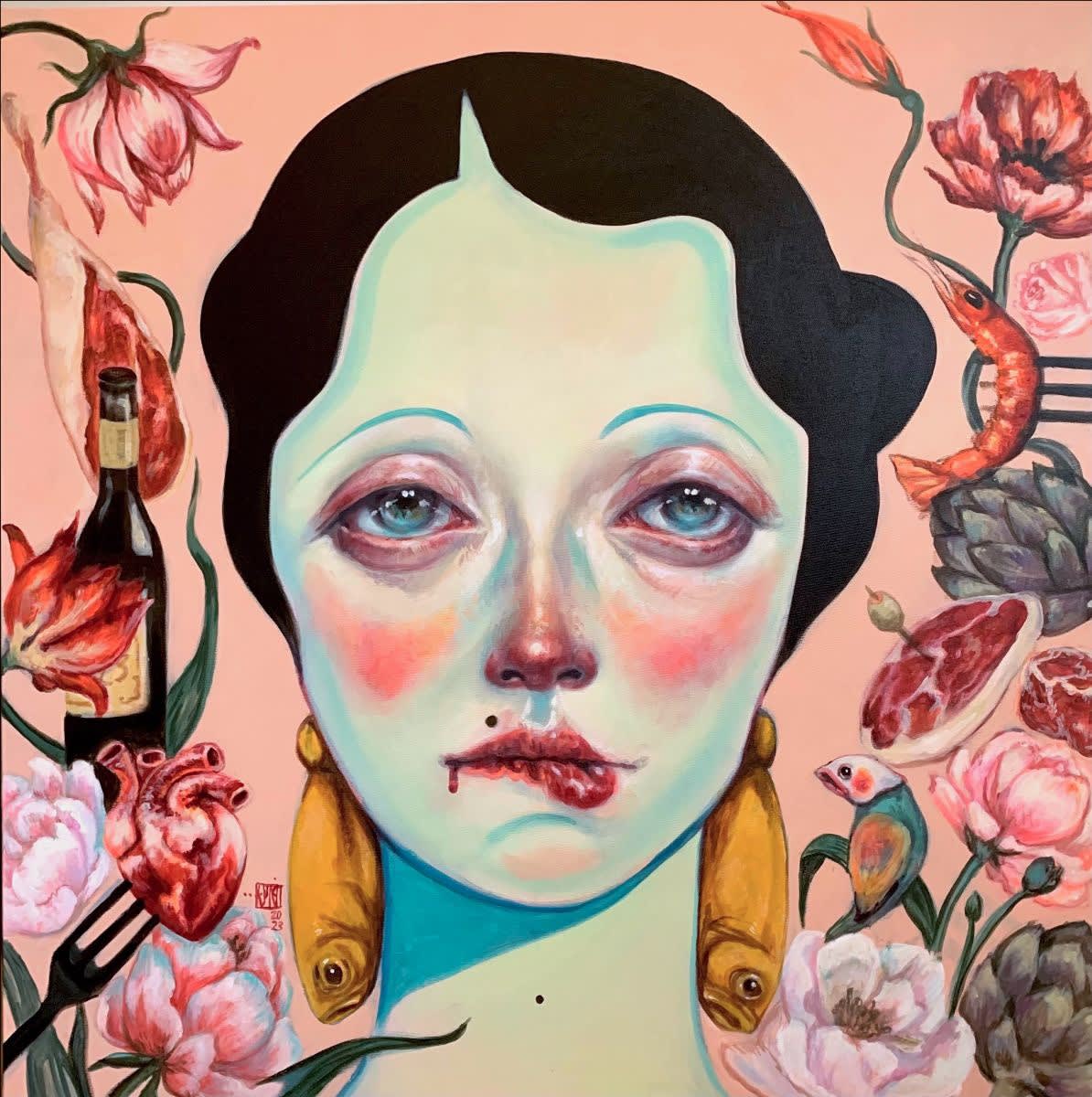
Bon Appétit Madame by Afarin Sajedi (90 x 90 cm), 2023
"I truly adore faces. I love the details and drawing the intricacies of the face. Especially the eyes, I focus a lot on those because I believe they truly represent people's thoughts, without the possibility of lying. The eyes are the mirror of the soul"
Afarin Sajedi
Finally, but certainly not least, Afarin Sajedi, a bold Iranian painter, focuses her art on femininity and women's empowerment in contemporary society. In her new work, she explores the concept of "Pink", infusing her characters with a mix of intensity and irony. Sajedi draws inspiration from various cultures, including the works of Renaissance masters, rococo tones, Shakespearean plots, and novels by Cervantes and Calvino. Sajedi's pieces not only convey a powerful message of emancipation but also stimulate dialogue and reflection on sensitive issues regarding women's roles in society. Her work presents an opportunity to explore and better understand the complex and multifaceted nuances of contemporary femininity.
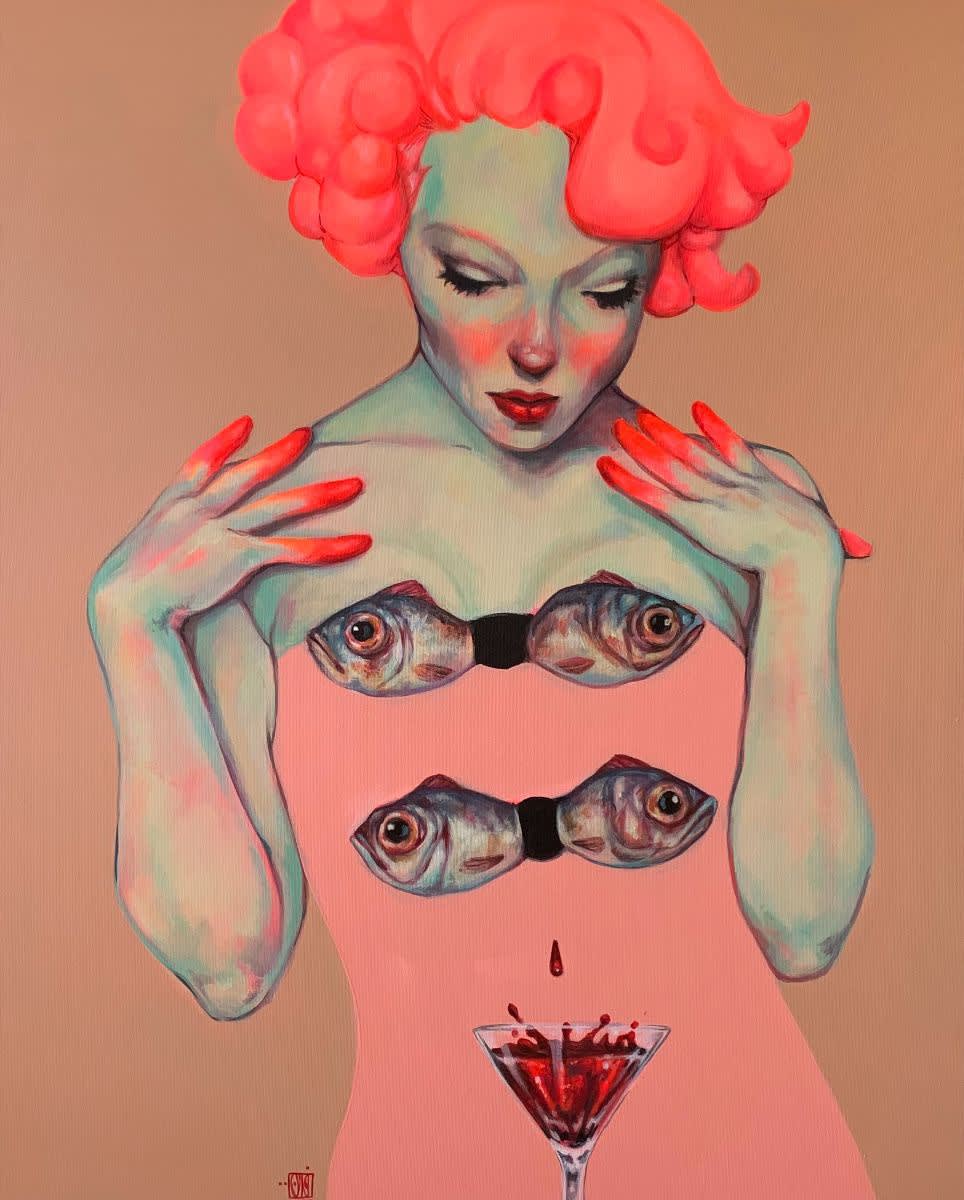
Bloody Mary by Afarin Sajedi (100 x 81 cm), 2023
With this exploration of the color pink, and especially with the exhibition "Pink Me Up", we aim to celebrate the profound and magical power of art, reveling in its ability to uplift our spirits and ignite our imaginations. This extraordinary showcase invites us to explore the many facets of the color pink through the eyes of visionary artists from diverse cultures. Each artwork tells a unique story, channeling emotions and ideas that challenge us to reflect on the world around us and discover new creative horizons. In this space dedicated to art, we immerse ourselves in beauty and inspiration, recognizing the power of creativity in nourishing our souls and connecting us with the deepest essence of our humanity.













